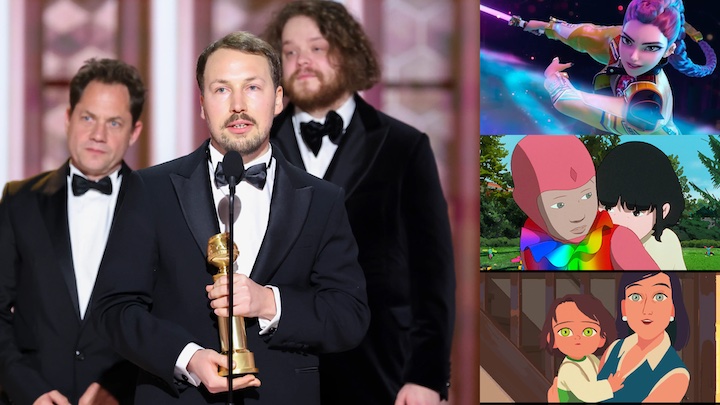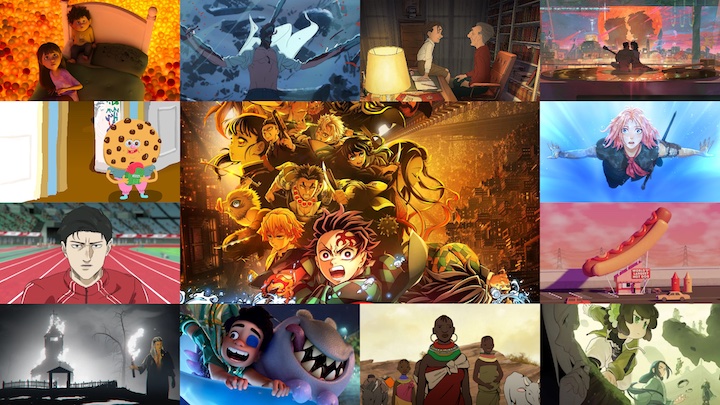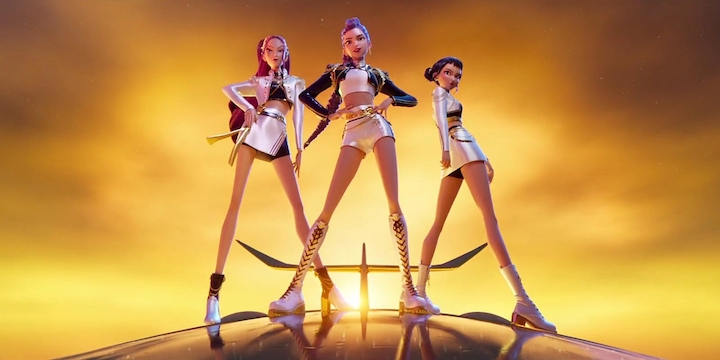A website dedicated to animation, awards, and everything in between.

Credit: Trash (ESMA)
One man’s trash is an animal’s dinner, and they’re ready to fight for it. Trash was a joint effort between eight students at ESMA Lyon (Gregory Bouzid, Maxime Crançon, Robin Delaporte, Mattéo Durand, Romain Fleischer, Alexis Le Ral, Margaux Lutz, Fanny Vecchie) for their graduation project. The eight directors spent almost a year and a half on this six-minute short centered on a rat and a pigeon’s fierce battle over a slice of pizza. Trash won Best in Show at SIGGRAPH, qualifying it for consideration at the 98th Academy Awards. Cartoon Contender spoke to several of the directors about turning “trash” into treasure.

The Directors of Trash (Alexis Le Ral, Fanny Vecchie, Robin Delaporte, Margaux Lutz, Gregory Bouzid, Maxime Crançon, Mattéo Durand, Romain Fleischer)
Q: Was Trash always pitched as a fight between a pigeon and a rat, or did any other animals come up during the conceptual phase?
Maxime Crançon: The choice of animals was a key decision that evolved a lot during production. In my initial pitch for what would become Trash, the main characters were an opossum and a crow. We later felt those choices were a bit “too cool,” and since opossums aren’t really common in France, we decided to rethink it. At one point, we even considered street cats, but quickly realized that a rat and a pigeon made much more sense. They’re everywhere in cities, familiar yet often ignored, and their seemingly harmless nature made them perfect for the story we wanted to tell.
Q: Trash centers on a rat and a pigeon, but what do you think the film says about humanity?
Robin Delaporte: We collectively reflected on what we wanted to express about humanity, and it was this reflection that, through the story of the rat and the pigeon, allowed us to portray a vision of the human condition. I think our goal was first and foremost to create a shift in how the audience perceives the characters. By choosing a pigeon and a rat, we deliberately picked two very common animals that most people instinctively find repulsive, yet through the story, we wanted that feeling to gradually transfer onto the humans instead.
For me, the portrait we painted in Trash speaks above all about indifference toward others. Each character lives in their own bubble, caught up in their flaws, completely unconcerned with what the others are doing or experiencing around them. They live in a kind of self-satisfied abundance, not necessarily rooted in wealth but in comfort, and find contentment in it, ignoring those who have less. That’s the broader image I would give of the humans depicted in this story. Even though, when focusing on each individual, one could also speak of cruelty, laziness, or voyeurism… Ultimately, it is through their detachment from the collective, their lack of empathy and connection, that the story of Trash, and that of the rat and the pigeon, truly takes shape.
Q: As grimy as the environment and characters are, Trash is truly a stunning piece of work. How did you strike a balance between gritty and gorgeous?
Gregory Bouzid: It was one of the challenges we anticipated the most, to develop an artistic direction that could suit the dirty and repulsive universe of the movie and help us “Find Beauty within the Dirty.” We were inspired by the amazing art of Bozo Balov, who paints in VR, creating 3D characters that seem to have no internal structure. It makes everything very organic and full of life, a simple subject can become inspiring and gain a lot of individuality as it looks aged and rugged. In Trash, brushstrokes are physically scattered all over the items and characters, so it breaks the edges, and it all becomes imperfect. The textures seem to leak out of the objects as if it was painted in a rush or a disorderly manner. From afar, it looks pretty and realistically detailed, but as you get closer, you realize the roughness of our environments and characters, and it disturbs the eye (in a good way!)
Q: The rat and pigeon cross paths with many people as they fight over the pizza. It’s almost as if several different tales are occurring in the background. Did you come up with any intricate backstories for these side characters?
Fanny Vecchie: That’s right! We took the time to imagine a story and personality for each secondary character. It really helped us define their appearance, their apartment, and enrich the whole scene with visual and sound details. For example, in the second-to-last window, you can see a husband assaulting his wife. She’s wearing an evening dress, as if they were coming back from an event, and their apartment is very tidy, minimalist, almost luxurious, which creates a strong contrast with the violence in their relationship. Right next door lives a man in his forties, in an old, run-down apartment. He still lives with his widowed mother and spends his days in front of the TV, wearing the same dirty clothes. He hears the neighbors’ screams but doesn’t react, he just keeps switching channels, even turning up the volume. He’s aware of what’s happening, but the only thing it causes him is annoyance, which is why there’s a “for sale” sign hanging under their window.

Credit: Trash (ESMA)
Q: The film is an adrenaline rush, and the cinematography plays a key role in that. Was the intent to make the camera feel like a character?
Maxime Crançon: Yes, absolutely. From the very beginning, we wanted the camera to feel alive, like a third character peeping into the action. We spent countless hours figuring out the right camera paths to make every movement feel natural and immersive. A lot of our approach was inspired by long sequence shots from action films, as we wanted the camera to flow seamlessly through the chaos while keeping that organic, almost voyeuristic energy.
Q: Tokyo Godfathers and Tekkonkinkreet have been singled out as inspirations, along with directors like Ari Aster, David Fincher, and Gaspar Noé. Do you think there’s one thing all of the above have in common?
Fanny Vecchie: Yes, I think there are several common threads among these artists. They all have the ability to create strong, immersive atmospheres, where every detail matters in telling a story or evoking emotion. Through visuals, sound, or direction, they can fully immerse the viewer in their world, often with striking contrasts and intense emotions. While remaining highly innovative, each of them has a distinct identity and style, you can often recognize one of their works. Also, their worlds, though very personal and unique, frequently tackle important topics, sometimes social, and often with a darker undertone.
Q: Artists can have conflicting visions. On Trash, did the team generally see eye to eye throughout production, or were there any creative clashes over the film’s direction?
Romain Fleischer: I think it is almost impossible for artists to collaborate on a fourteen-month creative project and remain perfectly aligned artistically. This is particularly true for a student production with not just one, but eight directors. Adapting to each other’s vision becomes essential. On Trash, we were fortunate to share a strong common understanding of the message we wanted the film to deliver. However, we often had very different ideas about how that message should be expressed. We faced disagreements and had to compromise, but that pushed us to refine our intentions, improve our communication, and find a visual language that belonged to all of us rather than just one individual.
Q: Trash won Best in Show at SIGGRAPH, which qualifies it for Oscar consideration. What have been some standout memories of taking the film on the festival circuit?
Robin Delaporte: Recently, I had the opportunity to go to Vancouver with Maxime to attend SIGGRAPH. Given the reputation and overall importance of this event in the film industry, but also in the broader field of imagery, it truly was an unforgettable experience for me. Having the chance to meet people from all around the world working in prestigious studios, seeing them appreciate our film, winning first prize at the festival, and going up on stage in front of an audience largely made up of long-time industry professionals... All of these moments really made this festival a memorable experience for us.
Q: One last question: favorite pizza topping?
Maxime Crançon & Fanny Vecchie: The best pizza is the “chèvre miel” (goat cheese and honey).
Robin Delaporte: Pepperoni, and there is no debate about it!
Nick Spake is the Author of Bright & Shiny: A History of Animation at Award Shows Volumes 1 and 2. Available Now!






